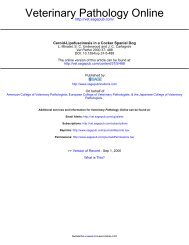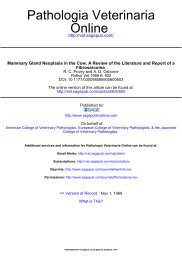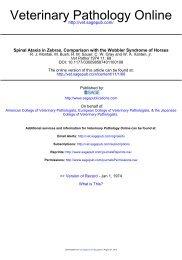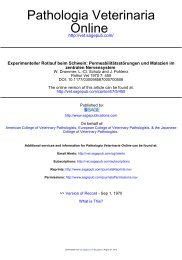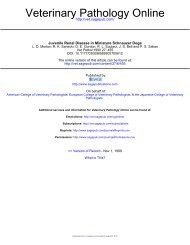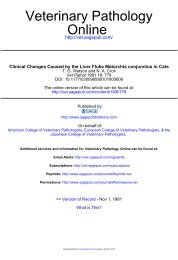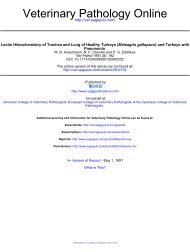Xanthomatous Keratitis, Disseminated Xanthomatosis, and ...
Xanthomatous Keratitis, Disseminated Xanthomatosis, and ...
Xanthomatous Keratitis, Disseminated Xanthomatosis, and ...
Create successful ePaper yourself
Turn your PDF publications into a flip-book with our unique Google optimized e-Paper software.
Veterinary Pathology Online<br />
http://vet.sagepub.com/<br />
<strong>Xanthomatous</strong> <strong>Keratitis</strong>, <strong>Disseminated</strong> <strong>Xanthomatosis</strong>, <strong>and</strong> Atherosclerosis in Cuban Tree Frogs<br />
J. L. Carpenter, A. Bachrach, Jr., D. M. Albert, S. J. Vainisi <strong>and</strong> M. A. Goldstein<br />
Vet Pathol 1986 23: 337<br />
DOI: 10.1177/030098588602300320<br />
The online version of this article can be found at:<br />
http://vet.sagepub.com/content/23/3/337<br />
Published by:<br />
http://www.sagepublications.com<br />
On behalf of:<br />
American College of Veterinary Pathologists, European College of Veterinary Pathologists, & the Japanese College of Veterinary<br />
Pathologists.<br />
Additional services <strong>and</strong> information for Veterinary Pathology Online can be found at:<br />
Email Alerts: http://vet.sagepub.com/cgi/alerts<br />
Subscriptions: http://vet.sagepub.com/subscriptions<br />
Reprints: http://www.sagepub.com/journalsReprints.nav<br />
Permissions: http://www.sagepub.com/journalsPermissions.nav<br />
>> Version of Record - May 1, 1986<br />
What is This?<br />
Downloaded from vet.sagepub.com by guest on August 26, 2013
Vet. Pathol. 23:337-339 (1986)<br />
<strong>Xanthomatous</strong> <strong>Keratitis</strong>, <strong>Disseminated</strong> <strong>Xanthomatosis</strong>, <strong>and</strong><br />
Atherosclerosis in Cuban Tree Frogs<br />
J. L. CARPENTER, A. BACHRACH JR., D. M. ALBERT,<br />
S. J. VAINISI, AND M. A. GOLDSTEIN<br />
Xanthomas are white or yellow non-neoplastic papules,<br />
nodules, or plaques that contain excess lipids <strong>and</strong> often cholesterol<br />
esters. Microscopically they are characterized by aggregates<br />
of lipid-laden macrophages with abundant foamy<br />
cytoplasm or by cholesterol granulomas. Veterinary literature<br />
contains reports of xanthomas in mammals, birds, <strong>and</strong><br />
a reptile.3.5.6,8,1L-15 Lipid keratopathy characterized by lipid,<br />
cholesterol, <strong>and</strong> cholesterol ester deposits in one or both eyes<br />
occurs in adult dogs4<br />
Cuban three frogs inhabit the West Indies, <strong>and</strong> from Cuba<br />
they spread to southern Florida on ships carrying vegetables.<br />
One frog in this report was a vagabond that traveled to Boston<br />
in a lettuce crate shipped from Florida <strong>and</strong> upon discovery<br />
was given to the Museum of Science. These nocturnal frogs<br />
have toe suction disc <strong>and</strong> a body length up to 12 cm. Their<br />
skin secretion when in contact with human mucous membranes<br />
will elicit pain. In southern Florida, they have been<br />
found in the Everglades, lakes, ponds, cisterns, <strong>and</strong> in other<br />
moist, shady areas. Their natural diet consists of insects,<br />
spiders, <strong>and</strong> other smaller tree frogs.<br />
An adult female Cuban tree frog residing at the Museum<br />
of Science in Boston, Massachusetts, <strong>and</strong> fed on day-old mice<br />
developed an apparently painless, white, stromal infiltrate in<br />
the cornea adjacent to the right temporal limbus. No corneal<br />
or conjunctival exudate accompanied the lesion, <strong>and</strong> the left<br />
eye was normal. Over a 2-month period, the corneal lesion<br />
developed into an elevated mass that involved the temporal<br />
third of the cornea <strong>and</strong> extended into <strong>and</strong> thickened the<br />
adjacent sclera. Therapy with a topical broad-spectrum antibiotic<br />
was unsuccessful, <strong>and</strong> the eye was enucleated.<br />
About 2 months later, similar lesions were seen at the nasal<br />
<strong>and</strong> temporal areas of the left cornea. A parenteral injection<br />
of 20 units of vitamin A as well as daily oral administration<br />
of multiple vitamins failed to halt the progression of the<br />
lesions. Within 1 month, all but the central cornea was involved.<br />
Cultures of cornea scrapings isolated Aeromonas hydrophila,<br />
Pseudomonas aeruginosa, <strong>and</strong> acid-fast bacilli, but<br />
were negative for fungi. Lethargy <strong>and</strong> decreased mobility<br />
prompted another general examination. Subcutaneous nodules<br />
were evident over the extensor surfaces of the stifles <strong>and</strong><br />
hocks. Joint movement was not noticeably restricted therefore<br />
it was concluded that decreased motor activity was due<br />
to blindness or to systemic disease. The frog was humanely<br />
killed <strong>and</strong> necropsied.<br />
At the Lincoln Park Zoo in Chicago, Illinois, two Cuban<br />
tree frogs that were fed crickets <strong>and</strong> meal worms had bilateral<br />
corneal dystrophies diagnosed by biomicroscopic examination<br />
as cholesterosis. Blood <strong>and</strong> eyes were collected at euthanasia<br />
for lipid <strong>and</strong> cholesterol analyses. Necropsies were<br />
performed to determine if they too had disseminated xanthomas.<br />
<strong>Disseminated</strong> xanthomas were found only in the frog from<br />
the Museum of Science, Boston. They occurred in the cornea<br />
<strong>and</strong> sclera, penarticular soft tissues over extensor surfaces<br />
(Fig. l), digital pads, brachial, lumbar, <strong>and</strong> femoral nerves<br />
(Fig. 2), ovaries, lung, gastric submucosa, brain, <strong>and</strong> pituitary.<br />
Distinct xanthomas, as well as diffuse regions of xanthomatous<br />
inflammation, contained numerous cholesterol<br />
crystals seen by polarization of frozen sections <strong>and</strong> as lenticular<br />
clefts seen in paraplast-embedded sections. Neutral<br />
lipids were abundant, occumng as large globules <strong>and</strong> as distinctly<br />
intracytoplasmic droplets with oil-red-0 stains. In<br />
addition, there were many foamy macrophages; occasional<br />
multinucleated giant cells, melanocytes/melanophores, mast<br />
cells; <strong>and</strong> a few penvenular lymphocytic infiltrates. Fibrosis<br />
was prominent with abundant intercellular matrix that failed<br />
to stain with PAS <strong>and</strong> stained very lightly with alcian blue.<br />
Mineralization within the xanthomas was infrequent. Acidfast<br />
bacilli, hemosiderin, <strong>and</strong> products of phagocytized elastic<br />
fibers sometimes present in foamy macrophages were absent.<br />
The corneal xanthomas of both eyes were similar grossly<br />
<strong>and</strong> microscopically (Figs. 3, 4). Extracellular cholesterosis,<br />
together with lipid accumulation that stained with oil-red-0,<br />
<strong>and</strong> the ensuing granulomatous reaction produced the white<br />
opaque lesions of the cornea <strong>and</strong> sclera that extended into<br />
the ciliary body. The ins, choroid, retina, vitreous, <strong>and</strong> lens<br />
were normal.<br />
The brain was largely replaced by a xanthoma that apparently<br />
developed in the region of the third ventricle, <strong>and</strong><br />
a smaller xanthoma in the hypothalamus extended into the<br />
neuropil <strong>and</strong> pituitary (Fig. 5). The liver <strong>and</strong> spleen were<br />
devoid of xanthomas, but both contained abundant fat that<br />
stained with oil-red-0. Neutral fat in the hepatocytes accounted<br />
for about half of the liver mass. Mononuclear phagocytes<br />
of the splenic red pulp contained fat, hemosiderin, <strong>and</strong><br />
melanin.<br />
Atherosclerosis involved both the aorta <strong>and</strong> femoral arteries<br />
(Fig. 2). Skeletal muscles of the limbs exhibited motor<br />
unit atrophy <strong>and</strong> small xanthomas associated with nerves as<br />
well as foci of interstitial penvascular lymphocytes. The epithelial<br />
cells of the renal proximal convoluted tubules contained<br />
an abundance of ferric iron.<br />
No lesions were found in the ears, skin, nose, tongue, intestines,<br />
thyroid, pancreas, adrenals, oviduct, vertebrae, or<br />
spinal cord.<br />
The two frogs from the Lincoln Park Zoo had corneal<br />
lesions similar to those in the frog from the Museum of<br />
Science, but no xanthomas or atherosclerosis were found.<br />
One frog also had a small cholesterol granuloma (cholesteatoma)<br />
of the choroid plexus of the fourth ventricle. Both<br />
frogs had geologic stones in the stomach <strong>and</strong> gastrointestinal<br />
nematodes. Serum cholesterol <strong>and</strong> lipid values were essentially<br />
the same for the two frogs (cholesterol = 196 <strong>and</strong> 20 1<br />
mg/dl, triglycerides = 84 <strong>and</strong> 94 mg/dl, high-density lipo-<br />
Downloaded from vet.sagepub.com by guest on August 26, 2013
338 Brief Communications<br />
Fig. 1. Periarticular xanthomas over extensor surfaces of the knee (right center) <strong>and</strong> hock with skin removed. Cuban<br />
tree frog.<br />
Fig. 2. <strong>Xanthomatous</strong> <strong>and</strong> granulomatous sciatic neuritis with many cholesterol clefts. Atherosclerosis of adjacent<br />
femoral artery (bottom). HE.<br />
Fig. 3. <strong>Xanthomatous</strong> keratitis <strong>and</strong> scleritis involving three-fourths of the right eye of a Cuban tree frog. (Courtesy of<br />
Dr. Gustavo Aguirre.)<br />
Fig. 4. Cornea. Numerous cholesterol clefts, large foamy macrophages, <strong>and</strong> blood vessels obscure the substantia propria.<br />
HE.<br />
proteins = 22 <strong>and</strong> 25, <strong>and</strong> low-density lipoproteins = 62 <strong>and</strong><br />
65 mg/dl).<br />
In humans, xanthomas may occur in acquired disorders<br />
such as hypercholesterolemia of liver disease <strong>and</strong> lipemia of<br />
diabetes mellitus <strong>and</strong> pancreatitis as well as in familial dysbetalipoproteinemia,<br />
hypercholesterolemia, <strong>and</strong> lipoprotein<br />
lipase deficiency.' Xanthomas also accompany some malignancies,<br />
especially myeloproliferative diseases <strong>and</strong> lympho-<br />
sarcoma.Io Skin diseases of infants <strong>and</strong> adults that have a<br />
primary histiocytic phase before granuloma or xanthoma<br />
forms include juvenile xanthogranuloma <strong>and</strong> xanthoma disseminatum.I6<br />
Xanthoma disseminatum of man, a rare, non-familial disorder<br />
of unknown etiology, is often characterized by a triad<br />
of diabetes insipidus, widespread xanthomas, <strong>and</strong> xanthomatous<br />
involvement of the upper respiratory tract.9 Lesions<br />
Downloaded from vet.sagepub.com by guest on August 26, 2013
Brief Communications 339<br />
of crickets <strong>and</strong> earth worms. Future study of the Cuban tree<br />
frog as a potential animal model for xanthomatosis, xanthomatous<br />
keratitis, or atherosclerosis requires nutrition <strong>and</strong><br />
genetic investigation, <strong>and</strong> analysis of serum cholesterol, lipid,<br />
<strong>and</strong> lipoprotein of normal <strong>and</strong> affected frogs.<br />
Fig. 5. Mid-longitudinal section through cranium, brain,<br />
<strong>and</strong> pituitary (arrow) of a Cuban tree frog. Half of the brain<br />
is replaced by a multinodular xanthoma (center); a smaller<br />
xanthoma in the hypothalamus extends posteriorly into the<br />
pituitary. PAS.<br />
occur as papules, nodules, or plaques in mucous membranes,<br />
sclera, brain, pituitary, <strong>and</strong> flexor surfaces of the extremities.2<br />
Histiologic features are a secondary accumulation of lipids<br />
<strong>and</strong> cholesterol within those histiocytes in patients with norm~lipemia.~<br />
The etiology of the generalized xanthomas <strong>and</strong> of the xanthomatous<br />
keratitis in the Cuban tree frogs is not determined.<br />
The distribution of the disseminated xanthomas, except that<br />
extensor surfaces are involved rather than flexor surfaces,<br />
resembles that of xanthoma disseminatum in man. Also similar<br />
is the lack of spontaneous resolution of the lesions. Microscopically<br />
the xanthomas in the frogs are dissimilar from<br />
human xanthoma disseminatum <strong>and</strong> can be distinguished<br />
by prominent fibrosis, including both collagen <strong>and</strong> elastic<br />
fibers, <strong>and</strong> by lack of multinucleated foam cells of Touton<br />
type.' The multinucleated cells in the frog lesions appear to<br />
be a response to cholesterol crystals. Autophagocytosis of<br />
iron <strong>and</strong> elastin, reported in some human patients with xanthoma<br />
disseminatum, was also absent in the frog lesions.<br />
Although not substantiated, the xanthomas of the hypothalamus<br />
<strong>and</strong> pituitary, like those in human xanthoma disseminatum,<br />
may have caused diabetes insipidus in the frog.<br />
Blood cholesterol <strong>and</strong> lipid values did not indicate lipemia<br />
nor was there morphologic evidence in the pancreas, liver,<br />
thyroid or kidneys of primary causes of lipemia in the frogs.<br />
Iron deposits in the renal proximal tubular epithelium appeared<br />
to be unrelated to the pathogenesis of the xanthomatous<br />
lesions.<br />
The xanthomas as well as the atherosclerosis in one frog<br />
were likely caused by some common factor(s) concerning<br />
nutrition. The diet consisted solely ofday-old mice. The milk<br />
contained within the stomachs of those mice should also be<br />
considered as part of that frog's diet. None of the eight female<br />
Cuban tree frogs, ranging from 1 to 52 months of age, that<br />
were necropsied at the Philadelphia Zoo had xanthomatous<br />
lesions (personal communication). Their daily diet consisted<br />
Addendum<br />
Two Cuban tree frogs photographed by Dr. Gustavo Aguirre<br />
at the Philadelphia Zoo had ocular lesions grossly similar to<br />
those in the three frogs reported here. This evidence suggests<br />
that xanthomatous keratitis of the Cuban tree frog is most<br />
likely not a rare disease.<br />
References<br />
1 Ackerman AB: Histologic Diagnosis of Inflammatory<br />
Skin Diseases, p. 469. Lea & Febiger, Philadelphia, 1978<br />
2 Allen AC: Skin. In: Pathology, ed. Anderson, 6th ed.,<br />
p. 1643. The CV Mosby Company, St. Louis, 1971<br />
3 Chastain CB, Grahan CL: <strong>Xanthomatosis</strong> secondary to<br />
diabetes mellitus in a dog. J Am Vet Med Assoc 172:<br />
1209, 1978<br />
4 Dice PF The canine cornea. In: Veterinary Ophthalmology,<br />
ed. Gelatt, p. 365. Lea & Febiger, Philadelphia,<br />
1981<br />
5 Fawcett J, Dermmaray SY, Altman N: Multiple xanthomas<br />
in a cat. Feline Pract 7(3):31, 1977<br />
6 Haley PJ, Norrdin RW: Periarticular xanthomatosis in<br />
an American Kestrel. J Am Vet Med Assoc 181: 1394,<br />
1982<br />
7 Have1 R J: Disorders of lipid metabolism. In: Cecil Textbook<br />
of Medicine, ed. Wyngaarden <strong>and</strong> Smith, 16th ed.,<br />
p. 1084. WB Saunders, Philadelphia, 1982<br />
8 Jones TC, Hunt RD: Veterinary Pathology, 5th ed., p.<br />
1682. Lea & Febiger, Philadelphia, 1983<br />
9 Kumakiri M, Sudoh M, Wivra Y: Xanthoma disseminatum,<br />
report of a case with histological <strong>and</strong> ultrastructural<br />
studies of skin lesions. J Am Acad Dermatol4:29 1,<br />
1981<br />
10 Murphy GF, Kwan TH, Mihm MC Jr: The skin. In:<br />
Pathologic Basis of Disease, ed. Robbins, Cotran, <strong>and</strong><br />
Kumar, 3rd ed., p. 1270. WB Saunders, Philadelphia,<br />
1984<br />
11 Peckham MC: <strong>Xanthomatosis</strong> in chickens. Am J Vet<br />
Res 16:580, 1955<br />
12 Petrak ML, Gilmore CE: Neoplasms. In: Diseases of<br />
Cage <strong>and</strong> Aviary Birds, ed. Petrak, 2nd ed., p. 6 10. Lea<br />
& Febiger, Philadelphia, 1982<br />
13 Ryan M J, Whitney GD: Xanthoma in a gopher snake.<br />
VMISAC 75503, 1980<br />
14 Ridgway RL: Oral xanthoma in a budgerigar, Melopsittacus<br />
undulatus (a case report). VM/SAC 72:266, 1977<br />
15 Sanger VL, Lagace A: Avian xanthomatosis. Etiology<br />
<strong>and</strong> pathogenesis. Avian Dis 10:103, 1966<br />
16 Winkelmann RK, Kossard S, Fraga S: Eruptive histiocytoma<br />
of childhood. Arch Dermatol 116:565, 1980<br />
Request reprints from Dr. J. L. Carpenter, Department of<br />
Pathology, Angel1 Memorial Animal Hospital, 350 S. Huntington<br />
Ave., Boston, MA 02 130 (USA).<br />
Downloaded from vet.sagepub.com by guest on August 26, 2013



